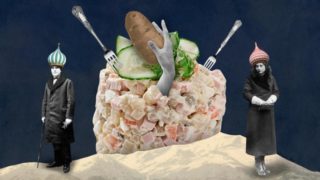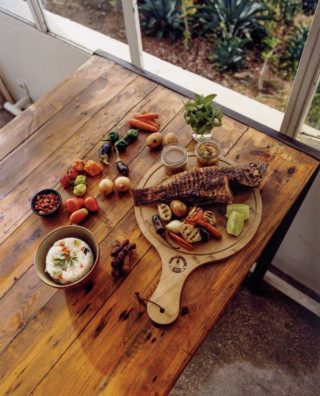How the meal of the masses became a new-year favourite
It is the afternoon of New Year’s Eve and I’m with my mother in the kitchen of our home in Omsk, south-west Siberia. Pots of boiling water steam the windows, obscuring the snowdrifts outside. On the table are mounds of potatoes, gherkins, carrots, eggs and chicken breast waiting to be diced. It’s a marathon I find meditative but my mother finds trying. As we chop we sing along to the rom-com on tv, “The Irony of Fate, or Enjoy Your Bath!”, a subtly anti-Soviet satire from 1976 set on New Year’s Eve, full of songs and catchphrases that every Russian knows by heart.
We’re making Olivier salad, the centrepiece of New Year’s Eve, which in Russia is more important than Christmas. Russian salads, among which the Olivier is king, are not the leafy green creations the name evokes elsewhere. Typically rich in mayonnaise, root vegetables and some sort of protein, they hold their own as a main course and deliver the calories necessary to withstand a Russian winter.
Ironically for a dish that became a favourite of the Soviet people, the Olivier started out as a delicacy reserved for the elite. It was invented by Lucien Olivier, head chef of the Hermitage restaurant in Moscow in the early 1860s. Modelled on the grand cafés of Paris, the Hermitage catered to the Russian upper classes and intelligentsia, including Turgenev and Tchaikovsky.
An ingredient designed to help combat food shortages was soon itself in short supply
Olivier took his cue from pre-revolutionary French cuisine: an elegant arrangement of grouse, cornichons, crayfish tails, capers, peas, potatoes and caviar, dressed with a special egg-based sauce. Despite the artful presentation, the Hermitage’s regulars tended to mix all the ingredients up on the plate as soon as it arrived. So Olivier took to serving it as a chopped salad – and its longevity was assured. He took the recipe to the grave in 1883, leaving cooks to publish their best guesses in the decades that followed.
As befitted its origins, the salad briefly vanished after the Russian revolution before reappearing in the 1930s when Olivier’s former apprentice put it on the menu at his restaurant, Moskva. He renamed the dish Stolichnyi (capital), retaining the (ideologically sound) potatoes and peas and replacing the expensive, “bourgeois” ingredients with sausage, carrots and fermented cucumbers.
The secret dressing was replaced with Soviet mayonnaise. A triumph of mass production, it infused any dish with fat, protein and tangy flavour – a nutritious superfood designed to mitigate the effects of food shortages that often occurred under the command economy. It also had the benefit of disguising poor-quality ingredients.
The government promoted the revamped Olivier salad, along with other mayonnaise-based recipes, in “The Book of Tasty and Healthy Food” in 1939, an aspirational work that fused nutritional advice with propaganda. The volume was a hit, possibly because it was the only cookbook people could buy. It launched Russia’s love affair with mayonnaise, a flame that still burns brightly.
Unfortunately demand exceeded supply and for much of the 1950s and 1960s Soviet mayonnaise could be found only in restaurants or food shops in major cities. Nothing fires the appetite like scarcity, so when mayonnaise became more readily available in the 1970s, households across the land set about making the Olivier salad. My mother remembers standing in long queues for most of the ingredients: if she came across jars of mayo in August she’d buy two (the maximum you were allowed) and keep them until New Year’s Eve.
My mother would buy jars of mayo in August and keep them until New Year’s Eve
Each family has its own version of the Olivier. Some, like mine, use chicken instead of the classic “doctor’s sausage” (doktorskaya kolbasa) or apples instead of carrots. Whatever the ingredients, it is always made in vast quantities. In our family it was served in a cut-crystal bowl that would be topped up as we tucked in. We pushed salad onto our forks with a slice of rye bread and washed it down with fizzy drinks or “Soviet champagne” – the “sparkling wine for the masses” devised in the 1920s.
Today many urban Russians turn their nose up at stolid, traditional salads. But at new year snobbery flies away. We love the Olivier for its inimitable combination of tangy, sweet and creamy flavours. It’s the perfect accompaniment to all-night drinking (and hungover breakfasts) and it keeps for days. But what makes it special are the memories it evokes: of far-away family, the reverence for food felt by those who have gone without, and the hope that next year will be one of plenty. For me it will always taste of excitement, of better things to come.
ILLUSTRATION: SONIA ROY
By Alissa Timoshkina/The Economist






I have read a few of the blog posts on your blog these few days, and I truly like your way of blogging. I added it to my favorites site list and will be checking back soon. Please check out my site too and let me know your thought.
Well I truly enjoyed studying it. This subject procured by you is very helpful for proper planning.
Latwo byc przyjacielem dla kogos, kto jest twoim przyjacielem, ale byc przyjacielem dla kogos, kto uwaza sie za twego wroga – to kwintesencja prawdziwej religii. M. Gandhi.
Mezczyzna, ktoremu sie powiodlo, to ten, co zarabia wiecej, niz moze wydac jego zona. Kobieta, ktorej sie powiodlo, to taka, ktora znalazla takiego meza. S. Guitry Authentic +200ok